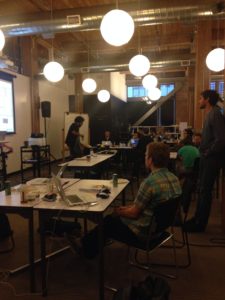 Stop shoveling out more stuff. Instead, set aside time to dig into stuff and discuss.
Stop shoveling out more stuff. Instead, set aside time to dig into stuff and discuss.
That’s the most optimal type of in-person meeting for peers who want to get together and experience new ah-ha moments.
Even though that advice from the New York University Neurobiologist Lila Davachi is almost two years old now, it’s not taken to heart – at least in the circles in which I travel.
The recent conferences I’ve attended as a speaker, panellist, and participant all have concentrated on cramming content into heads while keeping butts in seats.
(In the interest of full disclosure, Dr. Davachi’s advised in her “Rethinking Learning” session at the 2014 NeuroLeadership Summit that “instructional design needs to shift from content delivery to creating the space for insight.”)
What can you do to make the most of face-to-face conferences and other meetings to help adults connect with each other and the content and act on it?
Be social. Your overarching goal should be to make it easy for individuals to meet and greet, and then interact with each other.
Research shows that adults learn best and recall more when they have a positive emotional experience, which generally revolves around social elements. (For more about this, check out The Science of Making Learning Stick: An Update to the AGES Model.)
Here are five low-cost, relatively simple things you can do to encourage personal connections.
- Provide meeting participants with a list meeting of attendees with headshots in advance. This simple tool lets individuals easily identify who will be there. They can then figure out who they already know who they want to say “hello” to and who they want to meet. Granted, the list won’t be 100% accurate due to last minute cancellations and additions, but it’s helpful.
- Set aside time at the start of the meeting and each session for introductions. Depending on the size of the group, this can either be introductions of the entire group or by table. The introductions are useful in two ways: 1) They break the ice and 2) They send the signal that the conference organizers are encouraging connections.
- Ask participants to move to different seats, especially for events held in the same room for multiple days. When individuals change their perspective, they can change their perceptions. That will help them stay fresh, pay attention and synthesize what they learn. Plus, they can meet more people.
- Include interactive sessions for individuals to work together on a challenge or discuss an issue. While so many conferences tout their interactivity, the interaction is often between the speaker and the participants – asking and answering questions – not among participants. Exercises that participants can do together stimulate meaningful conversations that can lead to those wonderful ah-ha moments.
- Build time in the agenda to reflect at the end of each session. When the session leaders or event facilitators offer up a thought-provoking question about the just-presented content or ask participants about how they plan to apply their learnings, the participants get a chance to take a few moments to think about what they’ve heard, integrate it with their other knowledge and experience, and consider what to do next. This action starts to move the content from the theoretical to the practical. And if participants pair off to talk about this, the action becomes more social, emotional, and memorable for them.
Also consider providing regular 20 to 30-minute food and drink breaks so participants can recharge and talk with fellow participants.
To continue the food theme, for events last a day or more, offer at least one communal meal. When participants eat together, they can build stronger connections with each other.
Or, better than nothing, at least arrange dine-arounds for individuals. By doing so, you’re making it easier for people to find a restaurant and dining companions, which for many is more pleasant than eating alone.
By appealing to humans’ social needs, you make the get-togethers more enjoyable and more memorable.
For example, the neuroscience research cited in the AGES model says that we tend to remember who we learned with first. Then, once we recall our co-conspirators, we start to retrieve the content from our common experience.
Yes, we humans are social. Face-to-face conferences and meetings should be social too. (For more on this, see To improve recall, use social learning.)
After all, bringing people together is expensive in terms of travel, meeting space and time.
So how about making the most of it? Eat, drink, be merry, and always be learning and remembering!
By the way, I’ll be doing that this coming week at the 2016 NeuroLeadership Summit. This year’s theme is Rethink the Organization. The NeuroLeadership Institute has a great track record of practicing what it preaches about brain-friendly face-to-face conferences.
What about you? How are you making the most of your face-to-face meetings?

0 Comments